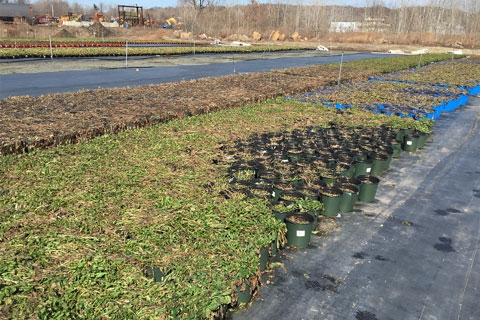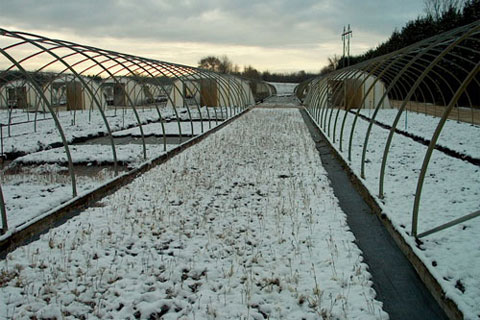8/1/2022
Minimizing Risk
Paul Pilon

When I think of overwintering perennials, the one word that pops to mind is risk. Overwintering plants can be risky. Most perennials can survive the winter in the landscape, but surviving above ground in a container is a whole different story.
The root systems in containers above ground don’t receive the same insulative properties as plants in the earth receive. The roots in pots are generally exposed to colder temperatures and wider temperature fluctuations than perennials in the ground experience during dormancy. Additionally, it’s more difficult to manage moisture levels during the winter in containers, which can lead to damage to the crowns when they’re kept too wet and/or damage to the roots when they’re kept too dry.
Pictured: It’s amazing how a single protective blanket can improve survival from cold spells. The image shows an area where there was a hole in the blanket. As shown, there was 100% mortality in the area without protection, whereas 100% survival in the areas that were covered. If you have doubts about the amount of cold protection blankets actually provide, seeing is believing—blankets do work!
I’ve seen numerous occasions where a crop looked perfectly fine prior to winter, but ended up quite the opposite with lots of variability and crop losses when growing conditions returned in the spring. In many instances, I’ve observed seemingly healthy plants in the fall end up with 100% mortality in the spring. Even excellent growers experience overwintering losses from time to time.
Why take on this risk
There are several reasons perennial growers opt to take on the risks associated with overwintering:
• Bulking. Many perennials benefit from being bulked up or allowed to have a period of time for them to size up before they’re overwintered. Most perennials have short bulking periods of six to eight weeks; the main goal is to allow enough time for them to become established and to grow a well-developed root system prior to winter. A few perennials, such as helleborus and hosta, have long bulking periods and should be planted in the late spring or early summer the year before they’re to be sold.
• Labor. Many growers opt to plant their perennials in the late summer or early fall to allow them to spread out their labor. It can be incredibly challenging for some growers to have enough labor to plant everything and perform all the necessary tasks around the greenhouse/nursery in the spring. Fall planting allows them to spread out the labor and allows them to focus on other important tasks in the spring.
• Plant quality. Several perennials must receive a cold treatment (vernalization) in order for them to produce flowers while vernalization is highly beneficial for flowering with other perennials. Since plants are bulked up prior to overwintering, they generally appear fuller, have more branches and produce more flowers than they would if they were planted during the same growing season they’re to be sold.
* Reduced heating. Following the cold treatment, plants that have been overwintered tend to grow faster and require less heat for them to reach a marketable stage in the spring. Many perennials can be grown cooler and/or for fewer weeks than they would need to be if they were spring-planted.
Managing risk
To better manage and minimize the risks associated with overwintering perennials, it’s important to understand and accept that the main goal of overwintering is the survival of the root systems. This may seem like common knowledge, but most growers don’t think of overwintering plants in this manner. Focusing on the survival of the root system will greatly increase overwintering successes.
Improving root health
Several weeks or even months before winter arrives, it’s important to ensure the roots are healthy in the fall. Crops with variability and unhealthy root systems are less likely to survive than crops with healthy root systems. Since you’re overwintering the roots, take steps to ensure the plants are well-established and the roots are healthy before attempting to overwinter them. Consider evaluating the root systems of each variety to be overwintered about four to eight weeks before the beginning of the cold treatment.
If the crops appear variable, the roots aren’t covering at least half the area of the container, and/or the roots appear unhealthy (brown/mushy), consider applying a broad-spectrum fungicide drench. An application at this time will allow new roots to develop before winter and increase the root’s ability to survive the winter. Unfortunately, many growers wait too long to apply these fall drenches, often making them at the onset of cold temperatures. This doesn’t allow enough time for the roots to improve, and fungicides are also less effective at controlling pathogens when the temperatures are cold and the pathogens are less active.
Early winter cold protection
As alluded to earlier, the roots of containerized plants don’t receive protection or any insulative properties from the ground. Depending on your geographic location, it may be necessary to protect the roots from cold temperatures. The amount of protection to provide will vary widely by geographic location, with southern growers needing little to no additional protection, whereas northern growers will likely need very extensive amounts of cold protection.
 From my experience, roots seldomly get damaged at the onset of winter. During the late fall, allow the roots to become well-acclimated to cold temperatures before using any type of additional cold protection. It’s okay, and even beneficial, for plants to receive frost and freezing temperatures. Moisture and fertility should be reduced during this period.
From my experience, roots seldomly get damaged at the onset of winter. During the late fall, allow the roots to become well-acclimated to cold temperatures before using any type of additional cold protection. It’s okay, and even beneficial, for plants to receive frost and freezing temperatures. Moisture and fertility should be reduced during this period.
Pictured: During the acclimation phase in the late fall and early winter, it’s beneficial to allow plants exposure to cold, frost and even light snowfall to help them become acclimated to cold prior to providing cold protection.
Placing plants inside structures will provide several degrees of cold protection; I usually anticipate that structures will provide temperatures about 5 to 10 degrees warmer than the outside temperatures. This is similar to the amount of cold protection blankets provide. When using blankets, avoid applying them too early; it’s best to wait until temperatures are consistently below freezing before applying them in the late fall/early winter. Covering them in this manner allows the plants more time to become acclimated to cold and withstand the much colder temperatures that lie ahead.
Late winter cold protection
Most cold injury and crop losses occur in the late winter, as the longer days and environmental conditions shift and wide temperature fluctuations between day and night occur frequently. Plants become de-acclimated with warmer temperatures or during extended periods of fluctuating temperatures. Once plants begin to de-acclimate, they’re more sensitive to cold exposure and under extreme conditions can become severely injured and even die.
I’d estimate that 90% of winter injury and death occurs in the late winter as the result of de-acclimation. Knowing and accepting that de-acclimation occurs in the late winter allows growers to react accordingly and take steps to protect their perennial crops when they’re most vulnerable to cold.
The first tactic is to delay de-acclimation and to reduce fluctuating temperatures when possible. During the late winter (beginning in February for me in Michigan), take steps to keep the temperatures from rising during the day inside structures. This can be done by actively managing the ventilation either automatically with environmental control systems or manually by opening vents and/or end doors on Quonset structures. Aim to keep the temperatures around freezing (30 to 35F/-1 to 2C) inside structures. It’s important to look at the weather daily and manage temperatures as needed during this time of the year.
Keep in mind that the plants will still appear dormant and will de-acclimate even though you can’t see growth. Besides managing temperatures where possible, it’s also helpful to take other steps, especially when outside temperatures well below freezing are expected. Minimum heat (30 to 35F) or protective blankets can be used inside structures to provide protection during cold spells.
With an understanding of when cold injury is most likely to occur and a little effort, growers can use strategies to manage temperatures, reduce or delay de-acclimation and protect their perennials when they’re most vulnerable. Plant survival during winter isn’t a given—every crop and every year is different—but there are things growers can do to actively minimize the risks of overwintering. GT
Paul Pilon is editor-at-large of the Perennial Pulse e-newsletter and Director of Growing at Opel Growers in Hudsonville, Michigan. He can be reached at paul@opelgrowers.com.